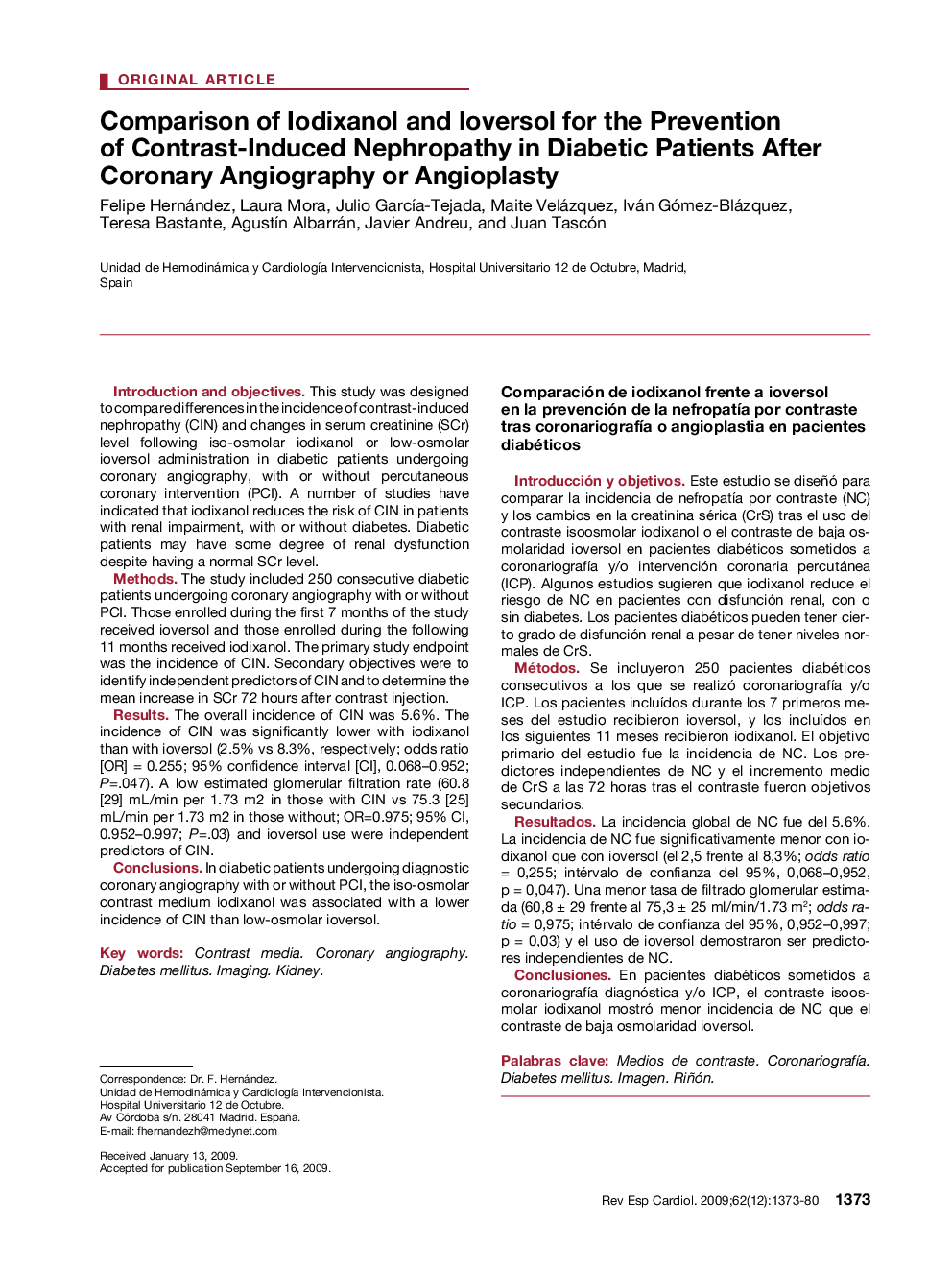| Article ID | Journal | Published Year | Pages | File Type |
|---|---|---|---|---|
| 3018826 | Revista Española de Cardiología (English Edition) | 2009 | 8 Pages |
Introduction and objectivesThis study was designed to compare differences in the incidence of contrast-induced nephropathy (CIN) and changes in serum creatinine (SCr) level following iso-osmolar iodixanol or low-osmolar ioversol administration in diabetic patients undergoing coronary angiography, with or without percutaneous coronary intervention (PCI). A number of studies have indicated that iodixanol reduces the risk of CIN in patients with renal impairment, with or without diabetes. Diabetic patients may have some degree of renal dysfunction despite having a normal SCr level.MethodsThe study included 250 consecutive diabetic patients undergoing coronary angiography with or without PCI. Those enrolled during the first 7 months of the study received ioversol and those enrolled during the following 11 months received iodixanol. The primary study endpoint was the incidence of CIN. Secondary objectives were to identify independent predictors of CIN and to determine the mean increase in SCr 72 hours after contrast injection.ResultsThe overall incidence of CIN was 5.6%. The incidence of CIN was significantly lower with iodixanol than with ioversol (2.5% vs 8.3%, respectively; odds ratio [OR] = 0.255; 95% confidence interval [CI], 0.068–0.952; P=.047). A low estimated glomerular filtration rate (60.8 [29] mL/min per 1.73 m2 in those with CIN vs 75.3 [25] mL/min per 1.73 m2 in those without; OR=0.975; 95% CI, 0.952–0.997; P=.03) and ioversol use were independent predictors of CIN.ConclusionsIn diabetic patients undergoing diagnostic coronary angiography with or without PCI, the iso-osmolar contrast medium iodixanol was associated with a lower incidence of CIN than low-osmolar ioversol.
Introducción y objetivosEste estudio se diseñó para comparar la incidencia de nefropatía por contraste (NC) y los cambios en la creatinina sérica (CrS) tras el uso del contraste isoosmolar iodixanol o el contraste de baja osmolaridad ioversol en pacientes diabéticos sometidos a coronariografía y/o intervención coronaria percutánea (ICP). Algunos estudios sugieren que iodixanol reduce el riesgo de NC en pacientes con disfunción renal, con o sin diabetes. Los pacientes diabéticos pueden tener cierto grado de disfunción renal a pesar de tener niveles normales de CrS.MétodosSe incluyeron 250 pacientes diabéticos consecutivos a los que se realizó coronariografía y/o ICP. Los pacientes incluídos durante los 7 primeros meses del estudio recibieron ioversol, y los incluídos en los siguientes 11 meses recibieron iodixanol. El objetivo primario del estudio fue la incidencia de NC. Los predictores independientes de NC y el incremento medio de CrS a las 72 horas tras el contraste fueron objetivos secundarios.ResultadosLa incidencia global de NC fue del 5.6%. La incidencia de NC fue significativamente menor con iodixanol que con ioversol (el 2,5 frente al 8,3%; odds ratio = 0,255; intérvalo de confianza del 95%, 0,068–0,952, p = 0,047). Una menor tasa de filtrado glomerular estimada (60,8 ± 29 frente al 75,3 ± 25 ml/min/1.73 m2; odds ratio = 0,975; intérvalo de confianza del 95%, 0,952–0,997; p = 0,03) y el uso de ioversol demostraron ser predictores independientes de NC.ConclusionesEn pacientes diabéticos sometidos a coronariografía diagnóstica y/o ICP, el contraste isoosmolar iodixanol mostró menor incidencia de NC que el contraste de baja osmolaridad ioversol.
